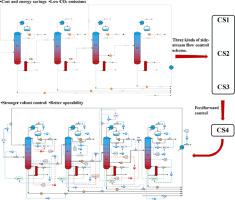Chemical Engineering and Processing: Process Intensification ( IF 3.8 ) Pub Date : 2021-06-24 , DOI: 10.1016/j.cep.2021.108510 Xiuyu zhu , Xiaoxiao Zhao , Zhishan Zhang , Zhun Ma , Jun Gao

|
Dynamic control of extractive distillation process with multiple liquid side-streams is challenging although it has an energy-saving potential. In this work, the optimal design and control of a high-efficient triple-side-stream quaternary extractive distillation process (TSQED) is presented for separating acetone/methanol/butanone/tert‑butanol. All operating parameters are optimized by a simulated annealing based systematic method, resulting in the reduction of total annual costs by 9.37%, energy consumption by 18.76%, and CO2 emissions by 33.17% as compared with conventional extractive distillation process. Subsequently, three control structures (CS1, CS2, and CS3) are proposed and demonstrated according to different side-stream flowrate control strategy. In the CS1, the side-stream flowrate is proportional to feed flow. In the CS2, the side-stream flowrate is proportional to reboiler vapor flow. In the CS3, and temperature-sensitive plate in distillation column is identified and cascaded by side-stream flowrate. By contrast, CS3 is far better than CS1 and CS2 in terms of dynamic responses and integral performance criteria. This attributes to the virtuous effect of the inferential temperature control on side-stream flowrate in the whole process control of TSQED. Finally, the feedforward control of QR/F is added in the CS4 to further improve the effectiveness of CS3.
中文翻译:

一种节能型三侧流四元萃取精馏工艺的优化设计与控制
尽管具有节能潜力,但具有多个液体侧流的萃取蒸馏过程的动态控制具有挑战性。在这项工作中,提出了用于分离丙酮/甲醇/丁酮/叔丁醇的高效三侧流四元萃取精馏工艺 (TSQED) 的优化设计和控制。所有操作参数均通过基于模拟退火的系统方法进行优化,与传统萃取精馏工艺相比,年总成本降低9.37%,能耗降低18.76%,二氧化碳排放量降低33.17%。随后,根据不同的侧流流量控制策略,提出并演示了三种控制结构(CS1、CS2 和 CS3)。在 CS1 中,侧流流量与进料流量成正比。在 CS2 中,侧流流量与再沸器蒸汽流量成正比。在CS3中,蒸馏塔中的温敏板通过侧流流速识别和级联。相比之下,CS3 在动态响应和整体性能标准方面远优于 CS1 和 CS2。这归因于TSQED全过程控制中推论温度控制对侧流流量的良性影响。最后,在 CS4 中加入了 QR/F 的前馈控制,以进一步提高 CS3 的有效性。这归因于TSQED全过程控制中推论温度控制对侧流流量的良性影响。最后,在 CS4 中加入了 QR/F 的前馈控制,以进一步提高 CS3 的有效性。这归因于TSQED全过程控制中推论温度控制对侧流流量的良性影响。最后,在 CS4 中加入了 QR/F 的前馈控制,以进一步提高 CS3 的有效性。











































 京公网安备 11010802027423号
京公网安备 11010802027423号